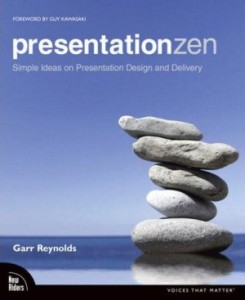Presentation Zen: Simple Ideas on Presentation Design and Delivery, written by Garr Reynolds, is an informative guide to presentation preparation, design, and delivery. If you’re not already familiar with the popular Presentation Zen blog, this book highlights many of his theories and techniques. If you’ve seen a presentation from famous presenters such as Seth Godin, Guy Kawasaki, or Steve Jobs, you’ll be familiar with the highly visual, stock-photo-heavy style that Reynolds advocates. Overall, I recommend this book (four of five stars) as a great resource for business presenters who want to improve their slides, not necessarily their PowerPoint skills.
Highlights of Presentation Zen
Chapter Three – Planning Analog: Reynolds covers the brainstorming process that typically involves “analog” methods such as pen and paper, whiteboards, and post-its. He recommends staying out of PowerPoint as you build the outline for your presentation. Reynolds provides a great list of “questions we should be asking” before any presentation including what is your main point and why does it matter. He also recommends creating detailed handouts to stop presenters from feeling as though they have to pack everything into their slides – a common cause of death by PowerPoint.
Chapter Six – Presentation Design Principles and Techniques: In this key chapter, the author covers seven helpful design principles – signal-versus-noise, empty space, picture superiority, contrast, repetition, alignment, and proximity. One of the most valuable aspects of this chapter is the before and after examples of how the concepts were applied to slides. These two chapters alone make the purchase of this book worthwhile for most business presenters.
Criticisms of Presentation Zen
So why didn’t I give this book five stars? I feel as though Presentation Zen is perfect for people who are preparing a presentation for a “big event” such as an annual company meeting, industry conference, major product launch, or key sales pitch. However, unless you’re Seth Godin or Al Gore, you’re not going to be doing several of these “big event” or keynote presentations each month or year.
The majority of business presentations are smaller presentations to internal teams or small external groups. For these “everyday” business presentations, you have constraints on your time, resources, budget, and freedom. Although I feel many aspects of Presentation Zen can be successfully applied to any presentation situation, it would have been good for Reynolds to acknowledge the “real-world” challenges that the majority of his readers face and provided specific guidance for these situations.
Another criticism of this book is that some of the chapters were noticeably weaker than others (Chapters 2, 5, 8, & 9). There were still valuable insights within these chapters – they were just a little harder to find. In some cases, it felt as though Reynolds was trying to force concepts into his “zen” framework and other times the content felt a little random, less developed, and disconnected from the rest of the book (e.g., Zander’s one-buttock playing).
In one part of the book, he contrasted the presentation styles of Steve Jobs and Bill Gates. Without providing any specific side-by-side slide comparisons or examples in his book, it was ineffective and felt a lot like unnecessary Microsoft-bashing (in contrast, he provides actual examples on his blog). Finally, I found it odd that Reynolds used George Lucas as an example of good editing and restraint. When I think of George Lucas, I think of unbridled special effects (i.e., flashy animations) and compromised storylines (i.e., poorly-formed presentations). Sorry if I’m still a little bitter after the last three Star Wars movies.
Despite these minor problems, Presentation Zen is a good addition to any presenter’s library. Garr Reynolds does a good job of challenging traditional presentation design and encouraging business presenters to take a new, fresh approach – one that is simple, visual, and memorable.
Check out Presentation Zen: Simple Ideas on Presentation Design and Delivery on Amazon.com.



April 9th, 2011 2:40 pm
[…] Zen review (taken from powerpoint ninja) The book on […]